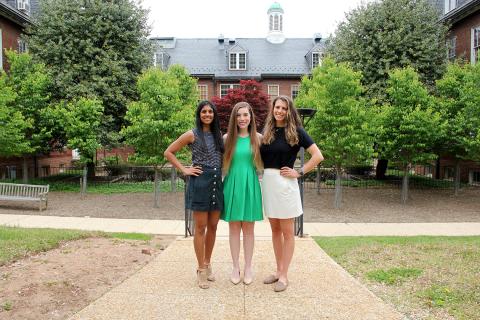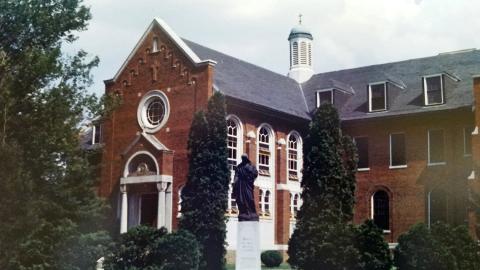Cloistered by Quarantine?
Medical Research Scholars Shelter in Place at NIH

When you list all the incredible experiences you might have as an NIH trainee, living like a cloistered nun probably doesn’t make your top 10. But if the global pandemic has taught us anything, it’s how to adjust to the unexpected. That’s what three students in the NIH Medical Research Scholars Program (MRSP) have been learning since mid-March when NIH shifted into extreme telework mode—like the rest of the country—to prevent spread of Covid-19.
Annah Baykal, Esha Chebolu, Layne Raborn and 47 other young people arrived at NIH last July as part of MRSP, a 12-month residential research-immersion program for medical, dental and veterinary students.
“They interrupt their medical school education to come to NIH to work in research labs that align with their career interests, to learn rigorous laboratory as well as clinical trial and epidemiology methods, to get career mentorship and leadership skills, to fine-tune their writing and presentation skills and otherwise see how top-tier research is done,” explained MRSP academic director Dr. Susan Leitman.

Photo: office of nih history
While training, the scholars live in Bldg. 60, the Mary Woodard Lasker Center for Health and Science Education, also known as “the Cloister.” The structure was built in 1923 to house an order of secluded nuns, the Sisters of the Visitation of Washington. They lived on the third floor of the building, in 10 small, bare bedrooms that were also called “cells.”
The nuns departed the Cloister in 1981 and NIH acquired the property, which was refurbished and expanded in 1985 through a partnership with the Howard Hughes Medical Institute. These days, the former cells, whose occupants share a kitchen and several bathrooms, are called “dorms” and every year they accommodate a corps of the MRSP. Other students live in apartments built in 1985.
The program was nearing its completion in March—with 5 men and 5 women residing dorm-style—when the lockdown occurred.
“After Covid-19, most of the dorm residents moved out, leaving me, Annah and Layne on the floor,” said Chebolu. “The dramatic end to all the social events was definitely the most noticeable [change]. Switching to telework has been different for everyone, based on their project. Some people are no longer able to do lab science at the bench and this has shifted their work balance greatly. However, my data analysis and paper-writing remain computer-based, and instead of walking to Bldg. 10 every day to complete my work, I take a few steps to the second-floor library.”

Chebolu, originally from Watertown, N.Y., attends the Jacobs School of Medicine and Biomedical Sciences at the University at Buffalo and trains with Dr. David Goldman, chief of NIAAA’s Laboratory of Neurogenetics, whose group is characterizing inter-individual variation in responses to alcohol use and associated genetic/clinical implications.
“The dorm rooms are unique because we sleep in the same rooms where nuns previously slept,” noted Raborn, who grew up in Baton Rouge and will soon enter her fourth year of medical school at Louisiana State University Health Sciences Center New Orleans. “Within each of our dorm rooms, there is a historical quote from the time when the nuns resided here. Staying here during this time, when we are limiting our exposure to the outside world, has given us an interesting perspective into the lives of the nuns who previously lived here.”

Training in NIDCR’s skeletal disorders and mineral homeostasis section led by Dr. Michael Collins, Raborn plans a career in plastic surgery. She conducted both clinical and translational projects focusing on fibrous dysplasia/McCune-Albright syndrome and tumor-induced osteomalacia, a disorder of excess fibroblast growth factor-23-mediated osteomalacia resulting in profound bone fragility.
After working at NIH, she “aspires to develop my field further through research and innovation. The surgeon-scientist as well as the physician-scientist career path has experienced a shortage in recent years. Although I have always wanted to continue research throughout my medical career, I hope that other future physicians will also consider the importance of research and incorporate research into their careers in light of Covid. I hope to bring attention to the importance of research and research funding during my future career.”
All three scholars admit that lessons learned during this unprecedented era go well beyond science and medical research.

“After Covid, I’ve tried to maintain somewhat of a [regular] rhythm,” said Baykal, who hails from the University of Oklahoma College of Medicine, Oklahoma City. “I know this time has been super-challenging on so many fronts—with transitions and uncertainty—but I’m definitely trying to see quarantine as a time for growth and development in one way or another…Everyone is in the same boat, though, and I think that helps. Having the other MRSP students to empathize and go through the lonely or frustrating times with has only made this year even more unique and life-transforming.”
Baykal works in NIDDK’s Diabetes, Endocrinology and Obesity Branch where Dr. Rebecca Brown is acting chief of the section on translational diabetes and metabolic syndromes.
“We study rare diseases of severe insulin resistance such as lipodystrophy and insulin receptor mutation syndromes in order to understand more about the biology of insulin signaling,” Baykal explained. “We then translate this knowledge to treat more common metabolic disorders such as obesity, metabolic syndrome and diabetes.”
Over the past year, the dorm mates bonded in many different ways and even traveled together, visiting Shenandoah National Park, New York City and New Orleans.

“The 10 of us got pretty close while living together and would often have ‘family dinners’ where we’d get together over homemade [meals] to catch up on the week,” Chebolu said. “We also had an MRSP volleyball team and enjoyed playing sand volleyball at the Lincoln Memorial courts in D.C. as well as in our own cloister backyard with other NIH faculty—and sometimes [NIH director Dr.] Francis Collins!”
Loss of that social life and sense of fellowship was difficult.
“I’ve been coping by trying to keep a routine with help and motivation from my floormates—just to keep a sense of normalcy,” Chebolu said. “I’ve been enjoying morning workouts with Annah, a normal 9-to-5 workday… and the three of us usually get together for dinner around the same time. It’s been really great to have them both here with me and I think we’ve all been supporting each other through these chaotic times.”
The scholars also faced professional and academic concessions.
“I was really looking forward to attending the ENDO 2020 conference with my lab in San Francisco at the end of March,” Baykal lamented, “and I was supposed to give an oral presentation on the project I’d been working on. But of course the meeting was canceled, which I was definitely bummed about.”
“Our MRSP curriculum, which the entire cohort partakes in, has shifted to virtual lectures,” Chebolu noted. “I was actually one of the first students to deliver my Journal Club presentation to my classmates via WebEx and we had to practice an entirely new way of presenting and entertaining questions. But it worked out really nicely and we continue to have lectures from distinguished faculty and student presentations in a virtual meeting format.”
Despite the unforeseen changes, scholars said their experience here exceeded expectations.

Photo: office of nih history
“My family is very excited that I am working—and living—at NIH during this time,” said Raborn. “I can see [the Vaccine Research Center] out of the Cloister windows—it is such an inspiring view!”
“I expected everyone at the NIH to be brilliant and I have not been disappointed,” said Baykal. “What took me by surprise was how everyone is so passionate and willing to teach and discuss ideas. The overall atmosphere promotes inquisitiveness and appreciation of everyone’s role in undertaking research. The nurses, postbacs, even cleaning staff all are treated with such respect. I could go on and on about how wonderful it is to work at the NIH.”
Chebolu, who wants to be an emergency medicine physician, concluded, “Covid-19 has definitely highlighted the sacrifices that come with the job. But, if anything, I am more excited to eventually be helping on the frontlines, if something like this were to happen again. Whether through research or clinical medicine, we all came into this field wanting to help people. And finally, all that time you spent studying in the library during medical school has a clear purpose in tumultuous times like these.”
Raborn agreed, “I am thankful that at the NIH, we are still able to conduct research and work during this time. As we know, health-related research has global importance and I am thankful that we are still able to contribute in this way…Readjusting research plans and schedules has been challenging but completely feasible. The sobering thing is seeing that even with ambition and resources, achieving results takes time. As we wait eagerly for more Covid-related research, I rest assured that all of the efforts towards stopping Covid will soon pay off!”
